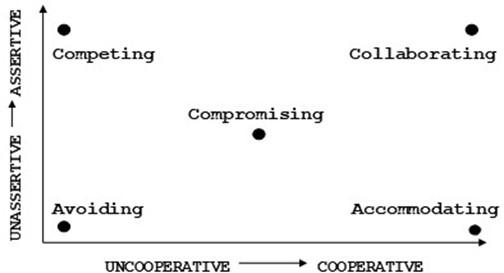
We can use various styles to handle conflict. We can do it quickly with little regard for the relationships that we harm. We can make consensus the goal and take the time needed to ensure that each and every person’s voice is heard and that their needs are met. We usually have a preferred style of conflict resolution, but we need to be able to use the style that is most likely to get us the outcome that we want.
Below is model that displays various ways to deal with conflict. It’s the Thomas-Kilmann Instrument (TKI) Model. You can take an assessment to figure out your preferred conflict style. Our individual preferences are nice to know, but it’s more important to understand that each of these approaches to conflict is appropriate in different situations.

(Thomas-Kilmann Instrument (TKI) Model)
First, let’s look at the model. Assertiveness is the vertical axis on the left side of the graph. The higher up a conflict style is on the graph, the more assertive it is.
The axis at the bottom indicates how cooperative a person is being when using a particular approach to conflict. The conflict approaches farther to the right use more cooperation than the ones on the left.
In workshops, I use the example of a mom and her children deciding where to go to dinner to illustrate the different approaches to conflict.
COMPETING. If you look at the graphic, you can see that when we use a Competing approach to conflict, we are being very assertive and very uncooperative. In the Competing style, we adopt an “I win and you lose” perspective. We are going to use everything we’ve got to get our own way. Relationships don’t matter to us.
In our dining example, the mom really wants Mexican food, and she tells the kids to get in the car because they are going to a Mexican restaurant. There is no discussion, and the children have no input.
We can only use the Competing style if we have the power to make everyone do what we want. For example, the five year old of the family would not be able to force the family to go for pizza because she can’t drive or pay.
There are times when the Competing approach is appropriate. The first situation is when safety is an immediate issue. I am going to yell at you to stop if you are about to walk into the street where a bus will inevitably hit you. If I am facilitating a class and the fire alarm goes off, I’m not going to ask the group how they want to leave the room and which exit they want to use. I’m going to tell them exactly what to do.
The military uses a Competing style in critical situations. No military leader in his or her right mind is going to take a vote on how to react to an ambush or how to move forward in an attack.
In the everyday world, we use lack of time as our reason for using a Competing approach. Most of us feel very busy, and we don’t think that we have time to ask for input and have a discussion about a situation or decision. It’s important to note that the input and discussion are worth the time and should be included whenever possible. People feel part of a decision when they have input. They also feel valued. The Competing style does not enhance the positivity of relationships and should only be used when absolutely necessary.
ACCOMMODATING. In an Accommodating style of conflict resolution, the outcome doesn’t matter to us. In our dinner example, the mom doesn’t really care where the family goes to dinner. Pizza may not be her favorite, but if that is what everyone else wants, she is willing to drive them there and eat some pizza.
As leaders, we want to use the Accommodating style whenever possible. We want to give others as much autonomy as we can. It’s motivating to have some power over how we do things or what we are achieving. Some leaders have trouble letting people do things their own way. Make an effort to let others lead and decide whenever you can.
It’s fine to leave the decisions to others when we truly don’t care about the outcome. It is not okay to say we don’t care when we really do – that’s passive-aggressive behavior. If I say that I don’t care where we go to dinner, I need to truly not care where we go to dinner.
AVOIDING. When we use an Avoiding conflict resolution style, we don’t take part in the conflict at all. We would be the teenager of the family who doesn’t want to be seen out in public with our lame family under any circumstance, so dinner is irrelevant. We aren’t assertive, but we also aren’t cooperative. We don’t care about what anyone else wants, and we don’t want to deal with them or the situation.
It is appropriate to use the Avoiding style when the situation has nothing to do with us. We often get worked up about decisions and how something “should” be done when we are not truly affected. For example, it may offend our moral sensibilities when someone is not working the way we believe that he or she should. However, performance issues are usually between a person and his or her supervisor. It’s best if we do our work to the best of our abilities and let them work it out. Our participation is not needed or helpful.
COMPROMISING. The Compromising approach is the one that is used most often and is appropriate much of the time. When using it, we ensure that everyone’s ideas are heard and then meet as many needs of as many people as possible in a reasonable amount of time.
Remember, our personal needs are to be listened to, understood, and respected. We can do all of those things when using a Compromising style and develop and maintain positive relationships.
When deciding where to go to dinner, we might take suggestions and then ask for a vote. Telling one child that she can choose where we go for dessert next time because she doesn’t want to go eat ice cream like everyone else is a Compromising style.
COLLABORATING. The Collaborating style is both very cooperative and very assertive. The goal is to satisfy the needs of everyone. This style requires a lot of time, energy, and commitment.
In our dinner example, we are going to make sure that everyone is happy with our restaurant choice and everyone is committed to making the best darn decision that we can. We are going to make a list of possible restaurants, ask for input from everyone, and consider how far each is from the house. We might create a list of average costs for a meal for each place that we are considering. We would also consider when each person ate last at the places being considered. We are going to spend a spend a good chunk of time on this and should probably be considering where to eat next week and not tonight.
The Collaborating style is appropriate for big, expensive decisions. If we are deciding where to build a new facility or whether or not to buy a house, we want to be sure that we have researched all the pertinent facts and unearthed as many advantages and disadvantages as possible. Using a Collaborative style helps to ensure that we aren’t missing any vital information needed to make a good decision.
We each have our own preferred style of conflict resolution. That style can change when we are stressed. It’s good to be aware of our preferences, but it’s also important not to be a one-hit wonder and only use that style. Great leaders use the style appropriate for the situation – no matter what their preferences are.
For a little bit of fun leadership development, join 53 Leadership Challenges at KathyStoddardTorrey.com.
Want to go further with your professional development? Check out the courses offered at PositiveEffectLeadership.com.
If you are interested in taking your career to the next level quickly, contact me for a sample coaching session at KSTorrey@tapferconsulting.com.
